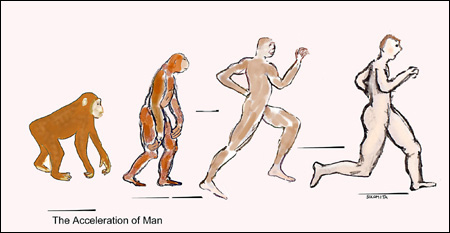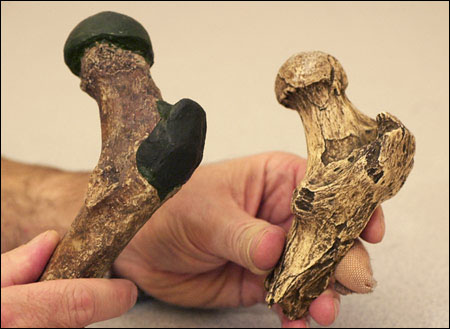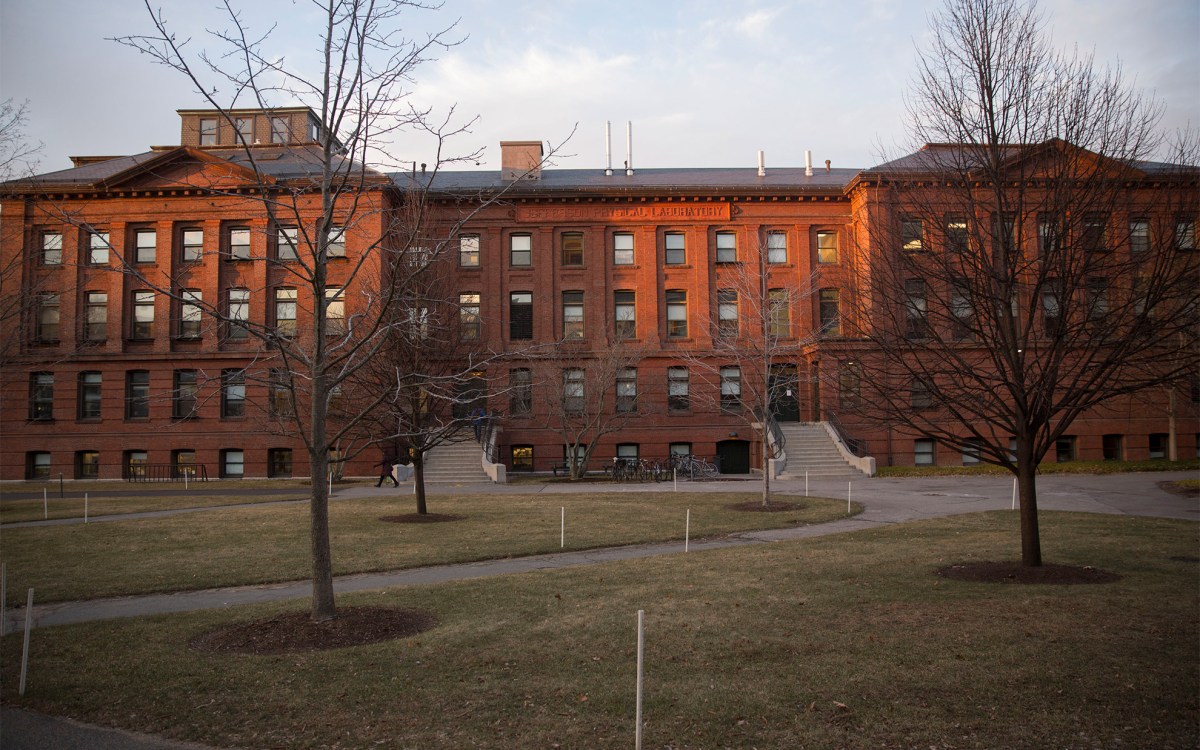Running paced human evolution
Anthropologists conclude running may have helped build a bigger brain

It all started with pigs on a treadmill.
Later came a close look at human rear ends and why they are so big. Added to the mix were studies of why our shoulders are disconnected from our heads, and why we have strong, springy tendons along the back of our legs that are not used for walking.
“All these anatomical features make humans surprisingly good runners. Over long distances, we can outrun our dogs and give many horses a good race,” says Daniel Lieberman, a runner, dog owner, and professor of anthropology at Harvard’s Peabody Museum. “What these features and fossils appear to be telling us is that endurance running evolved in order for our direct ancestors to compete with other carnivores for the protein needed to grow big brains.”
Lieberman sees this as a missing story in the history of evolution. The story of that story began about 13 years ago when he started working with Dennis Bramble, a University of Utah biologist interested in how animals run. Lieberman, who has a similar curiosity, was testing some pigs on a treadmill.

“Pigs are terrible runners,” he notes, “and Dennis introduced me to an esoteric bit of anatomy that explains why.” Pigs lack a so-called nuchal ligament, an elastic band of tissue that runs from a ridge on the base of the skull to the spine. It keeps an animal’s head steady when it runs. Horses, dogs, cheetahs, and other good runners have such a ligament.
Traces of a nuchal ridge can be found in skulls millions of years old, so the next step was to check the fossils of early humans at the renowned Peabody Museum. It turns out that neither the earliest prehumans or the chimps that are their nearest relatives have a nuchal ridge. But some later-evolving hominids did. Known as Homo erectus, these tall, upright people were similar to modern humans. From the neck down, we would identify with them.
The meaning of this discrepancy struck Bramble and Lieberman in the head, so to speak. Chimps and the stooped predecessors of H. erectus, known as australopithecines, spent much of their time in the trees and had no good reason to run around much. With their long arms and more apelike anatomy, they walked or climbed around Africa from about 6 million to 2 million years ago.
Two or 3 million years ago, when H. erectus came out of the trees and roamed the grassy savannas of Africa, running became a very handy thing for getting food. Four-legged animals can move like missiles, but tall, two-legged creatures move like pogo sticks. To be fast and steady, you need a head that oscillates up and down, but doesn’t pitch back and forth or bobble from side to side. The nuchal ligament is one of several features that allowed early humans to run with steady heads held high.
Running into evolution
“As we started to think more about the nuchal ligament, we became more excited about other features of bones and muscles that might be specialized for running, rather than just walking upright,” Lieberman notes. One that comes immediately to mind is our shoulders. The burly, permanently hunched shoulders of chimps and australopithecines are connected to their skulls by muscles, the better to climb trees and swing from branches. The low, wide shoulders of modern humans are almost disconnected from our skulls, allowing us to run more efficiently but having nothing to do with walking.

Then there’s buns. “They are one of our most distinctive features,” Lieberman comments. “They are not just fat but huge muscles.” A quick look at a fossil australopithecine reveals that his pelvis, like that of a chimp, can only support a modest gluteus maximus, the major muscle that comprises a rear end.
“These muscles are extensors of the hips,” Lieberman points out, “best used to push apes and australopithecines up the trunks of trees. Modern humans don’t need such a boost, and they don’t use their rear ends for walking. But the instant you start to break into a run, your gluteus maximus starts firing,” Lieberman notes.
Such “firing” stabilizes your trunk as you lean forward in a run, that is, as the center of body mass moves in front of your hips. “A run is like a controlled fall,” Lieberman explains, “and your rear end helps you stay up.”
Runners also get a lot of help from their Achilles tendons. (Sometimes a lot of trouble, too.) These tough, strong bands of tissue anchor our calf muscles to the heel bone. During a run, they act like springs that contract then uncoil to help push a runner ahead. But they’re not needed for walking. You can stroll across the African plains or city sidewalks without Achilles tendons.
Growing a brain
Despite all this special equipment, most humans don’t consider themselves to be sterling runners. They can’t keep up with their dogs, or run down a squirrel. There are plenty of measurements of the running capabilities of four-legged animals, as there are for humans. Bramble and Lieberman decided to do something that seems obvious, but had not been done before – compare the two sets of data.
“I was surprised at how well we did,” Lieberman admits. “We can’t beat most animals in a sprint, but we best many of them in endurance running. I can easily outpace my dog on a long run.” Antelopes and cheetahs sprint as fast as 65 miles an hour but not for very long. There are reports of African and Native American hunters who could run their prey to exhaustion, a feat of little use after the appearance of spears and bows and arrows.
Lieberman and Bramble list all the human specializations for running and compare our endurance-running performance with that of four-legged animals in the November 18 issue of the scientific journal Nature.
How did we become such good runners? Why did we evolve all these special features that we don’t use for walking?
“Imagine what life was like for our ancestors on the plains of Africa some 2-3 million years ago,” Lieberman answers. “How would you obtain a high protein meal without any weapons?” He describes a scenario of H. erectus “shopping.” Seeing vultures in the sky tips him off that there’s meat and marrow nearby. If he walks to the kill, hyenas and other scavengers will get what meat, marrow, and brains the big hunters like lions have left. You’ve got to run, and the faster, the better.
Protein and fat in the bones and skulls of prey are excellent food for growing the bodies and brains of predators. Bramble and Lieberman argue that running released the constraint on acquiring the protein and fat needed to grow the kind of brain that makes us human.
Lieberman is not sure how this story will be received by his colleagues. “Research on the history of human locomotion has traditionally been contentious,” he says. “At the very least, I hope this theory will make many people have second thoughts about how humans learned to run and walk and why we are built the way we are.”




